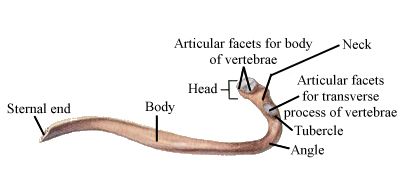rib

Anatomy of a vertebro-sternal rib.
A rib is any of the flat, arched bones that, with the spinal column behind and the sternum, or breastbone, in front form the protective framework around the heart and lungs known as the rib-cage. The term costal means pertaining to a rib or the region of the ribs.
In humans, there are 12 ribs on each side. The first seven are more directly connected through intervening cartilages with the sternum than the remainder and are called vertebro-sternal or true ribs; while the other five are known as false ribs, and the last two of these, from being free at their anterior extremities, are known as floating ribs.
The ribs vary quite a lot in both their direction and size. The upper ribs are nearly horizontal, but the others lie with their anterior extremity lower than the posterior; this obliquity increasing to the ninth rib, and then slightly decreasing. The ribs increase in length from the first to the eighth, and then again diminish. The spaces between the ribs are called intercostal spaces.
On examining a rib taken from about the middle of the series we find that it presents two extremities (a posterior or vertebral, and an anterior or sternal), and an intervening portion, termed the body or shaft. The posterior extremity presents a head, a neck, and a tuberosity. The head is marked by two concave articular surfaces divided by a ridge, the lower facet being the larger. These surfaces fit into the cavity formed by the junction of two contiguous dorsal vertebrae, and the ridge serves for the attachment of a ligament. The neck is a flattened portion proceeding from the head; it is about an inch long, and terminates at an eminence called the tuberosity or tubercle, from when the shaft commences. One the lower and inner part of the tubercle is a small oval surface, which articulates with a corresponding surface on the upper part of the transverse process of the lower of the two vertebrae with which the head is connected. The shaft presents an external convex and an internal concave surface. A little external to the tubercle the rib is bent to form the angle, from which point the rib passes forwards and outwards, ultimately curving inwards to join its costal cartilage (see next section). The upper border of the rib is thick and rounded, while the lower border is marked by a deep groove, which lodges the intercostal vessels and nerve.
Costal cartilage
A costal cartilage is a cartilage that connects a rib to the sternum (breastbone). The first seven ribs (true ribs) are directly connected to the sternum by individual costal cartilages. The next three ribs are indirectly connected to the sternum by three costal cartilages, each of which is connected to the one immediately above it.
Disorders of the rib
Fracture of the ribs is a very common surgical accident, resulting from blows or falls upon the chest. Ribs may also be broken by outward pressure, as when people are crushed in a crowd, or even, especially in older people, by violent coughing or sneezing. The fracture causes severe pain that is made worse by deep breathing. There is also tenderness and swelling of the overlying tissue. The diagnosis is confirmed by a chest X-ray. Pain is relieved by analgesic drugs or, occasionally, by the injection of a long-acting, local anesthetic.
Most rib fracture are undisplaced (i.e. the bone ends remain in alignment) and usually heal without specific treatment. Strapping is rarely used to to aid healing because it hinders chest expansion and thus increases the risk of pneumonia. Instead, the patient is encouraged to take deep breathes while holding the injured side. A fracture that is displaced may pierce a lung, thereby causing it to collapse.
A rib is one of the more common sites for a benign bone tumor or for a metastasis (a secondary malignant tumor that has spread from cancer elsewhere in the body).


